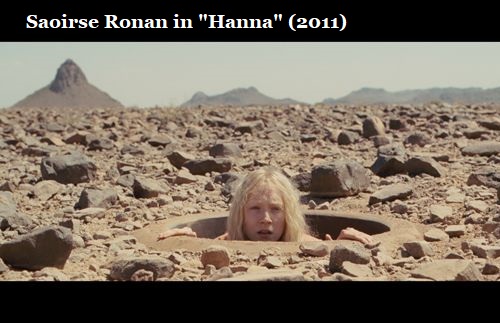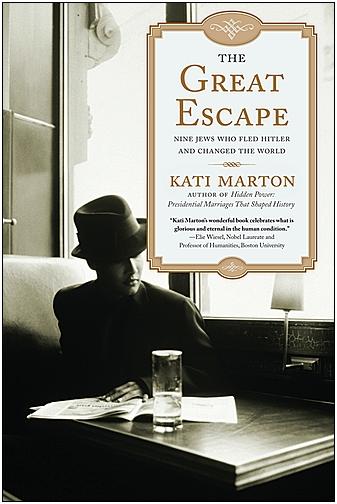
The above scene from "Hanna" comes from a webpage
dated August 29, 2011. See also …

The above scene from "Hanna" comes from a webpage
dated August 29, 2011. See also …
For Jews of Hungarian background
who do not worship Paul Erdős and
Rubik’s Cube:
The New Yorker 's review of The Great Escape (Simon & Schuster, $27), by Kati Marton—
"Marton, who fled Hungary as a child in 1957, illuminates Budapest's vertiginous Golden Age and the darkness that followed (a darkness that some of her subjects, notably Arthur Koestler, never shook)."
— Issue dated November 6, 2006
See also The Ninth Gate in this journal and the life of Marton's second husband, Peter Jennings.
From Koestler’s Darkness at Noon, a fictional Communist on propaganda:
“It is necessary to hammer every sentence into the masses by repetition and simplification. What is presented as right must shine like gold; what is presented as wrong must be black as pitch.”
Thanks for this quotation to Kati Marton, author of The Great Escape: Nine Jews Who Fled Hitler and Changed the World (Simon & Schuster, paperback edition Nov. 6, 2007). One of Marton’s nine was Koestler.

From another book related to this exodus:
“Riesz was one of the most elegant mathematical writers in the world, known for his precise, concise, and clear expositions. He was one of the originators of the theory of function spaces– an analysis which is geometrical in nature.”
— Stanislaw Ulam, Adventures of a Mathematician
And from Gian-Carlo Rota, a friend of Ulam:
“Riesz’s example is well worth following today.”
Related material: Misunderstanding in the Theory of Design and Geometry for Jews.
For a different approach to ethnicity and the number nine that is also “geometrical in nature,” see The Pope in Plato’s Cave and the four entries preceding it, as well as A Study in Art Education.
Angel of the
First Degree
 |
Honey Blonde She’s as sweet as tupelo honey She’s an angel of the first degree. She’s as sweet as tupelo honey Just like honey, baby, from the bee. — Van Morrison, 1971 |
By THE ASSOCIATED PRESS
Filed at 1:22 a.m. ET
Thursday, Aug. 19, 2004
LOS ANGELES (AP)– Elmer Bernstein, the versatile, Oscar-winning composer who scored such movie classics as “The Ten Commandments,” “The Magnificent Seven,”‘ “To Kill a Mockingbird,”‘ “The Great Escape” and “True Grit,” died Wednesday. He was 82.
Bernstein died in his sleep at his Ojai home.
That, M.C.C., is what
Fritz Leiber means by

Religious Symbolism
at Princeton
In memory of Steve McQueen (“The Great Escape” and “The Thomas Crown Affair”… see preceding entry) and of Rudolf Augstein (publisher of Der Spiegel), both of whom died on November 7 (in 1980 and 2002, respectively), in memory of the following residents of
The Princeton Cemetery
of the Nassau Presbyterian Church
Established 1757
|
SYLVIA BEACH (1887-1962), whose father was pastor of the First Presbyterian Church, founded Shakespeare & Company, a Paris bookshop which became a focus for struggling expatriate writers. In 1922 she published James Joyce’s Ulysses when others considered it obscene, and she defiantly closed her shop in 1941 in protest against the Nazi occupation. KURT GÖDEL (1906-1978), a world-class mathematician famous for a vast array of major contributions to logic, was a longtime professor at the Institute for Advanced Study, founded in 1930. He was a corecipient of the Einstein Award in 1951. JOHN (HENRY) O’HARA (1905-1970) was a voluminous and much-honored writer. His novels, Appointment in Samarra (1934) and Ten North Frederick (1955), and his collection of short stories, Pal Joey (1940), are among his best-known works. |
and of the long and powerful association of Princeton University with the Presbyterian Church, as well as the theological perspective of Carl Jung in Man and His Symbols, I offer the following “windmill,” taken from the Presbyterian Creedal Standards website, as a memorial:

The background music Les Moulins de Mon Coeur, selected yesterday morning in memory of Steve McQueen, continues to be appropriate.
“A is for Anna.”
— James Joyce
Powered by WordPress